
V1974 Cygni or Nova Cygni 1992 was a nova, visible to the naked eye, in the constellation Cygnus. It was discovered visually with 10×50 binoculars on February 19, 1992, by Peter Collins, an amateur astronomer living in Boulder, Colorado. At that time he first noticed it, it had an apparent magnitude of 7.2. Nine hours later he saw it again, and it had brightened by a full magnitude. For this discovery Collins was awarded the AAVSO Nova Award in 1993. The nova reached magnitude 4.4 at 22:00 UT on 22 February 1992. Images from the Palomar Sky Survey taken before the nova event showed identified a possible precursor which had photographic magnitudes of 18 and 17, but the identification of the precursor is not firm.

GK Persei was a bright nova first observed on Earth in 1901. It was discovered by Thomas David Anderson, an Edinburgh clergyman, at 02:40 UT on 22 February 1901 when it was at magnitude 2.7. It reached a maximum magnitude of 0.2, the brightest nova of modern times until Nova Aquilae 1918. After fading into obscurity at about magnitude 12 to 13 during the early 20th century, GK Persei began displaying infrequent outbursts of 2 to 3 magnitudes. Since about 1980, these outbursts have become quite regular, typically lasting about two months and occurring about every three years. Thus, GK Persei seems to have changed from a classical nova like Nova Aquilae 1918 to something resembling a typical dwarf nova-type cataclysmic variable star.

V476 Cygni or Nova Cygni 1920 was a nova which occurred in the constellation Cygnus in 1920. It was discovered by William Frederick Denning, an English amateur astronomer, at 09:30 GMT on 20 August 1920, at which time it had a magnitude of 3.7. It reached a peak brightness of magnitude 1.7 on 23 August 1920. Its quiescent brightness is magnitude 17.09.
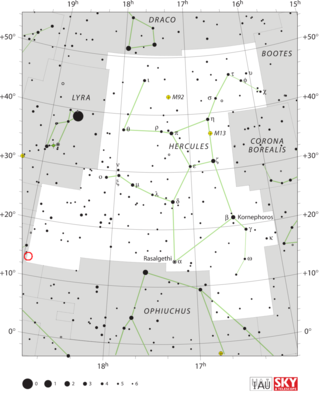
V446 Herculis was a nova in the constellation Hercules in 1960. It reached magnitude 2.8. The nova was first observed by Olaf Hassel in the early morning hours of 7 March 1960, when it was a 5th magnitude star. Pre-discovery photographs showed that it was about three days past peak brightness, and had faded by 2 magnitudes during that time. The star was so near the border between the constellations of Hercules and Aquila that accurate measurements of its position were needed to determine which constellation contained it.

V533 Herculis was a nova visible to the naked eye, which occurred in 1963 in the constellation of Hercules.

DK Lacertae was a nova, which lit up in the constellation Lacerta in 1950. The nova was discovered by Charles Bertaud of the Paris Observatory on a photographic plate taken on 23 January 1950. At the time of its discovery, it had an apparent magnitude of 6.1. DK Lacertae reached peak magnitude 5.0, making it easily visible to the naked eye.

V1059 Sagittarii was a nova, which lit up in 1898 in the constellation Sagittarius. The star reached apparent magnitude 4.5, making it easily visible to the naked eye. It was discovered on 8 March 1898, by Williamina Fleming on a photographic plate taken at the Harvard College Observatory. The discovery plate was an objective prism plate, part of the Henry Draper Memorial Photographs, and Ms Fleming identified it as a nova based on its spectral characteristics.

Sakurai's Object is a star in the constellation of Sagittarius. It is thought to have previously been a white dwarf that, as a result of a very late thermal pulse, swelled and became a red giant. It is located at the center of a planetary nebula and is believed to currently be in thermal instability and within its final shell helium flash phase.
VX Sagittarii is an asymptotic giant branch star located more than 1.5 kiloparsec away from the Sun in the constellation of Sagittarius. It is a pulsating variable star with an unusually large magnitude range. It is one of the largest stars discovered, with a radius varying between 1,350 and 1,940 solar radii (940,000,000 and 1.35×109 km; 6.3 and 9.0 au). It is the most luminous known AGB star, at bolometric magnitude –8.6, which is brighter than the theoretical limit at –8.0.

RY Sagittarii is a yellow supergiant and an R Coronae Borealis type variable star in the constellation Sagittarius. Although it ostensibly has the spectrum of a G-type star, it differs markedly from most in that it has almost no hydrogen and much carbon.

V339 Delphini or Nova Delphini 2013 (PNV J20233073+2046041) is a bright nova star in the constellation Delphinus. It was discovered on 14 August 2013 by amateur astronomer Koichi Itagaki in Japan and confirmed by the Liverpool Telescope on La Palma. The nova appeared with a magnitude 6.8 when it was discovered and peaked at magnitude 4.3 on 16 August 2013. A nova is produced by the fusion of accumulated material on the white dwarf nova progenitor acquired from its companion star. The nova system is thus a binary star, and a classical nova. The white dwarf is a carbon-oxygen white dwarf, with an estimated mass of 1.04±0.02 M☉. There is not yet a consensus about what the binay's orbital period is; estimates range from 3.15 hours to 6.43 hours.

V1369 Centauri also known as Nova Centauri 2013 was a bright nova in the constellation Centaurus that occurred in 2013. It was discovered on December 2, 2013 by amateur astronomer John Seach in Australia with a magnitude of 5.5. On December 14, 2013 it peaked at about magnitude 3.3, making it the brightest nova so far of this millennium.

V1017 Sagittarii is a cataclysmic variable star system in the constellation Sagittarius. It first erupted in 1919, reaching magnitude 7. Its other eruptions in 1901, 1973 and 1991 only reached magnitude 10, leading it to be reclassified from a recurrent nova to a dwarf nova.

V5856 Sagittarii, also known as Nova Sagittarii 2016 Number 4, was the 4th and brightest nova that occurred in the constellation Sagittarius during 2016. It was discovered by the All Sky Automated Survey for SuperNovae on 25.02 October 2016, at which time it had an apparent visual magnitude of 13.7. It was independently discovered by Yukio Sakurai of Mito, Ibaraki, Japan on 26.38 October 2016, by which time it had reached magnitude 10.4. It reached its peak brightness of magnitude 5.4, making it visible to the naked eye, on 8 November 2016. The nova occurred within a region of the sky monitored by the OGLE microlensing experiment, and that group reported that no star brighter than magnitude 22 was seen at the nova's position prior to its eruption.
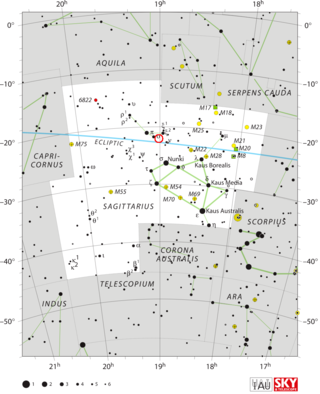
V4743 Sagittarii was a bright nova in the southern constellation of Sagittarius. This event was discovered by K. Haseda and colleagues in September 2002. It peaked at magnitude 5.0 on September 20, 2002, then declined rapidly thereafter. It reached a peak temperature of 740,000 K around April 2003 and remained at that level for at least five months, suggesting the white dwarf component has a mass of 1.1–1.2 M☉. The distance to this system is uncertain. Infrared observations indicate a distance of approximately 21 kly (6.3 kpc). A derivation using maximum magnitude rate of decay showed a distance of 12.7 ± 1.0 kly (3.9 ± 0.3 kpc).
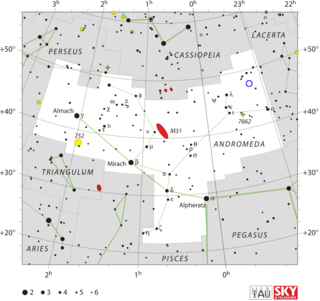
OS Andromedae, known also as Nova Andromedae 1986, is a classical nova that appeared in the constellation Andromeda during 1986. It was discovered at 10:34 UT on 5 December 1986 by Mitsuri Suzuki, a 28-year-old school teacher living in Ena, Japan. He photographed the portion of the Milky Way that passes through northern Andromeda with a 200-mm telephoto lens, and found the nova when its apparent magnitude was 8.0. Two days later it reached a peak apparent visual magnitude of 6.3.

V630 Sagittarii was a nova visible to the naked eye in 1936. It was discovered on 3 October 1936 by Shigeki Okabayashi of Kobe, Japan when it had an apparent magnitude of 4.5.
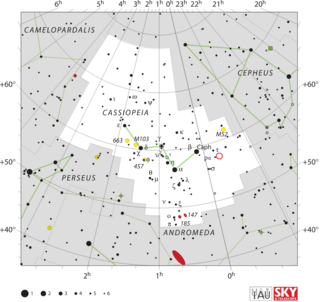
V705 Cassiopeiae, also known as Nova Cassiopeiae 1993 was a nova which erupted in the constellation Cassiopeia during 1993. The nova was discovered at 11:17 UT on 7 December 1993 by amateur astronomer Kazuyoshi Kanatsu of Matsue, Japan, who photographed it using a 35mm camera with a 55mm f/2.8 lens. Asteroid 6976 Kanatsu was named after him in honor of this discovery. At the time of its discovery the nova had a photographic magnitude of 6.5. Around 18 December 1993 it flared briefly to magnitude 5.3, and then it returned rapidly to magnitude 6.5. It underwent a series of smaller flares until mid February 1993, after which it began a precipitous decline in brightness.
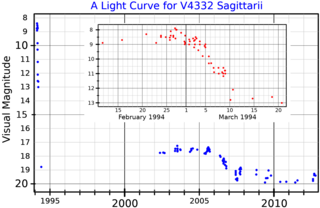
V4332 Sagittarii is a nova-like event in the constellation of Sagittarius. It was discovered February 24, 1994 at an apparent visual magnitude of 8.9 by Japanese amateur astronomer Minoru Yamamoto from Okazaki, Aichi, then confirmed by K. Hirosawa. Initially designated Nova Sagittarii 1994 #1, it was given the variable star designation V4332 Sgr. A spectra of the event taken March 4 lacked the characteristic features of a classical nova, with the only emission lines being of the Balmer series. Subsequent spectra showed a rapid decline in luminosity and a change of spectral type over a period of five days. By 2003, the object was ~1500 times less luminous than at peak magnitude and showed a spectrum of an M-type star.




















